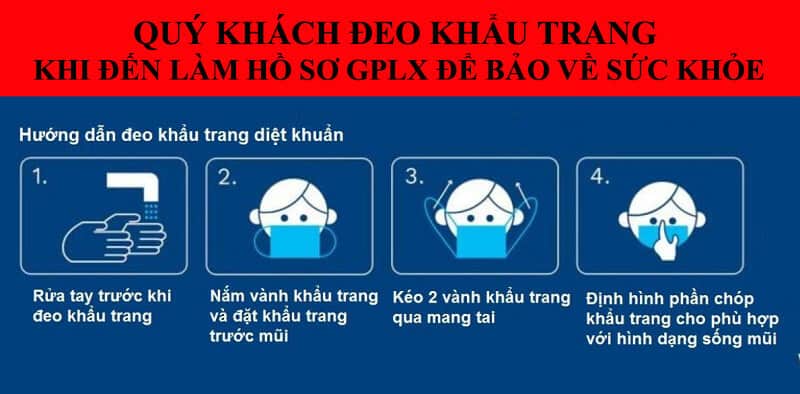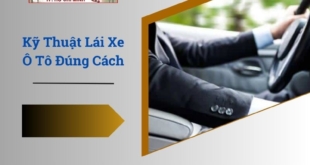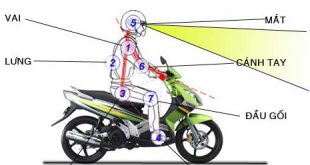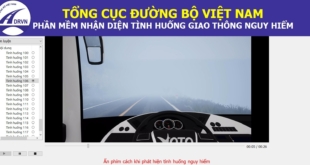Merging a car vertically into a parking space (rear parking) is a parking technique parallel to the curb, in which your car will be located between two other parked cars. This technique is often used in tight parking areas where there is not enough space to park perpendicular to the curb. In the car driving license test, parking a car vertically in a parking space is one of the difficult tests of the driving test, considered an important skill that drivers need to master.
The driver should clearly determine the size of the car and garage, follow the instructions, and memorize the principles and experience to place the car vertically in the most accurate parking place.
In addition, you need to learn about the test content, objectives, requirements and errors that will result in points being deducted from the test, then combine the car along the parking lot to prepare carefully before taking the test.
Understanding the difficulties that students encounter in the process of taking the test, HCM Driving Training & Testing School shares Experiences and Tips on Handling Vertical Parking of Cars for students' reference. Don't miss the article if you want to successfully merge vertical cars into parking spaces.
How to Determine the Size of the Car and Garage
If you want to practice parking the car vertically into a parking space well, you should determine the size of the car and the garage (parking place).
What vehicle sizes need to be kept in mind?
When transplanting a car vertically into a parking space, first note the size of the car, which is specified as follows:
- a is the vehicle body length. Vehicle body length is the length from the nose to the rear of the vehicle.
- b is the vehicle body width. The width of the vehicle is the width of the two sides of the vehicle.
What garage sizes need to be kept in mind?
After determining the size of the car, it is necessary to determine the size of the garage for the car to park. This size is specified as follows:
- Ld is the length of the garage = length a of the car + 1 meter.
- Rd is the width of the garage = width b of the car + 0,6 meters. Thus, in the case of an ideal transplant into the garage, each side will still be 0,3 meters wide for peace of mind.
- Ed is the control space to reverse the car. Ed is defined as = 1,2 x a. Located about 5,8 meters.
What division points need to be kept in mind?
After completing the two steps of determining the size of the vehicle and garage, students need to pay attention to the following division points:
- The dividing point between the garage, that is, the point that divides the garage in half, is also called the watch point c.
- Create a neutral position by drawing a straight line inclined 45 degrees to the face of the garage, cutting through the middle of the garage.
See details on how to determine the size of the car and garage, and the division points to note in the following video:
What are the steps to follow to park a car vertically?
After determining the size and dividing points that need to be noted, students perform vertical parking of the vehicle in the following 4 steps:
Step 1: Create a coordinate system
Determine the position of the person sitting in the car as the center of the axle system, the position of the person sitting in the car is about 30cm, shoulder level with the middle point of the car. At this time, the two rear wheels will be balanced between the two corners of the garage. Using the door latch as a reference point on the car, the coordinate system is now complete and proceed to step two.
Step 2: Right steering wheel (take advantage of the left glass)
Drive the vehicle parallel to the chip line so that the left side of the vehicle is 30cm-40cm away from the curb (control the clutch attachment point and let the vehicle drive slowly).
When your shoulders reach the front edge of the barn door, steer all the way to the right. When the vehicle body forms a 45 degree angle with the barn door, steer straight and then step on the brake and disconnect the clutch to stop the vehicle.
Step 3: Left steering wheel (take advantage of reverse gear + left windshield + right windshield)
When the car comes to a complete stop, put it in reverse gear and watch the rearview mirror, then slowly release the clutch to let the car start to reverse. When you see the left rear tire 30-40 cm from the left corner of the barn door, steer all the way to the left. When the vehicle body is parallel to the chip line, stop.
Step 4: Straight steering wheel (take advantage of the left glass) - end of lesson
Drive straight and reverse until the brake stops.
To end the test, the contestant drives the cart out of the barn to take the next test. At this time, you put the car in 1st gear, drive slowly straight up, until you see the shoulder level with the edge of the barn, then you have to turn the wheel all the way to the right to get out of the barn.
Watch the detailed video of the practice of vertically aligning a car into a parking space:
Experience in Matching Cars Vertically to the Correct Parking Place
Principle of vertical vehicle integration into the actual parking place
To combine the vehicle vertically into the actual parking place, the following 4 principles need to be applied:
Driving direction is opposite to reverse direction:
- When you steer left, the car will move back to the right.
- When you steer to the right, the car will move back to the left.
Moving forward, clinging to the back, retreating, clinging to the belly:
- Whichever side you retreat to, you will cling more to that side.
- Back to the right and stick to the abdomen (right side).
- Back to the left and stick to the abdomen (left side).
Drive at the right time:
- Determine the appropriate steering time.
- Adjust the appropriate speed.
- Avoid steering too early or too late.
Do not try to reverse when the vehicle is tilted:
- If you reverse too much, the rear of the car is close to or far away from the barn, let the car move forward.
- Steer to regain the corner.
- Back the car slowly into the barn.
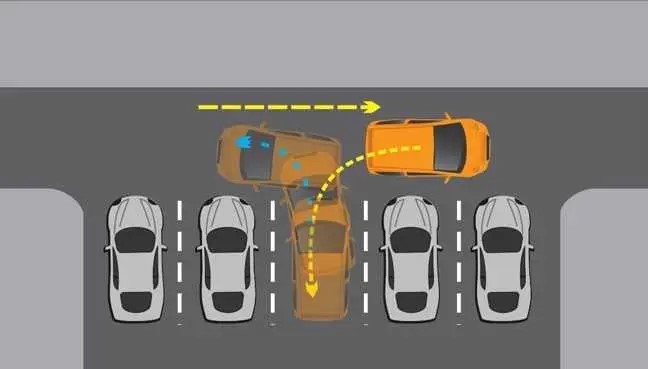
Tips for handling vertical cars in the correct parking spot
In the test of merging a car vertically into a parking space, students need to practice continuously and regularly to master the steps. Because in essence, if the above steps are followed correctly, this test can be passed easily.
Some experiences and "tips" to match vertical cars to the correct parking spot:
- Use rearview mirrors and cameras carefully to avoid collisions with other vehicles: Before backing up, check and adjust the rearview mirror to have the best view of the rear tires. In this situation, narrow-angle mirror adjustment should be applied. If you want to expand the viewing angle, you can install a convex car mirror.
- Reversing slowly and carefully, don't be in a hurry: Reverse gear is the strongest gear, works faster than first gear. Therefore, remember to always reverse the car at a slow speed. This will help the driver make adjustments more easily, avoiding oversteer and having to move forward and back. On the other hand, backing up slowly also helps the driver to promptly react if unexpected obstacles arise.
- Pay attention both before and after the actual vehicle alignment: When backing up, many people often only look behind and forget to pay attention to the front. This is quite dangerous. Because when steering, the nose of the car often points outward. If you are not careful, you may not be able to react in time if you suddenly encounter an obstacle, a pedestrian or a vehicle in front passing by.
- Practice regularly to improve your car pairing skills.
- Use road markings as landmarks to align vehicle position.
- Lower the car window to better observe your surroundings.
- Turn on the radio to relieve stress.
- Stay calm and focused when doing the pairing.
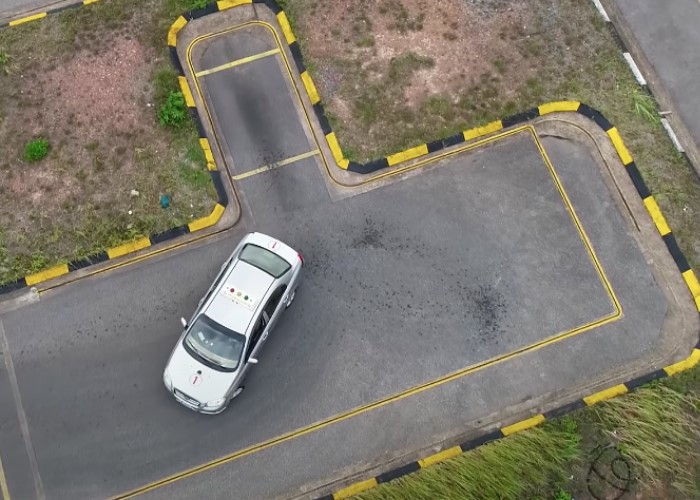
Questions Related to the Test of Handling Cars Vertically into Parking Places
Matching a car vertically to a parking spot is part of which test?
Matching a car vertically to a parking spot is one of 1 practice tests in the car driving test. This is the part of the exam that is easy to lose points and is the most difficult for beginners, so it is necessary to follow the steps given by the teacher, practice regularly and calmly handle the exam process.
What is the goal of the vertical car parking test?
The main goal of this test is to test the candidate's ability to control and maneuver a car into a vertical parking position. Competitors need to demonstrate the ability to control the vehicle, use proper driving techniques and score points for correctly and safely parking the vehicle.
What are the requirements for the vertical parking test?
The vehicle matching test along the parking area must comply with the following requirements:
- To complete the test within 2 minutes, you must be able to back into the parking space without touching the line and move out of the barn.
- Take the test within the specified road area for your test
- It is not allowed to leave the wheels on the three-car sidewalk and the limit line in the test image.
- You must ensure that the engine operates continuously and the vehicle must not stall during the test.
- From the time the front wheel touches the starting line until the rear wheel touches the finishing line must not exceed 2 minutes.
- The maximum engine speed when performing the test is 4000 rpm.
- Maximum driving speed is 24km/h for class B and D drivers and maximum 20km/h for class C and E drivers.
- Drive in accordance with the provisions of the Road Traffic Law.
Which error will result in points being deducted in the parking test?
Common mistakes that result in points being deducted in the parking test:
- If the vehicle exceeds the speed limit, 3 point will be deducted for every 1 seconds.
- If the engine speed exceeds 4.000 rpm, 5 points will be deducted each time.
- If the vehicle stalls, 5 points will be deducted each time.
- Parking in the wrong location (no end signal), 5 points will be deducted.
- If the wheel hits the air pipe limit line, 5 points will be deducted for every 5 seconds.
- Each time the wheel hits the air pipe limit line, 5 points will be deducted.
Disqualification errors:
- The car is stuck on the sidewalk, or driven onto the sidewalk.
- Driving not according to the vehicle class.
- Improper handling of situations causing accidents.
- The vehicle does not pass the parking spot after 30 seconds of parking.
- The car drops more than 50 cm after parking.
- At the end of the test without completing the vehicle pairing, the vehicle is still outside the vehicle pairing area.
Which center teaches how to align a car to a parking spot and train reputable drivers in HCM?
Although the car parking test always confuses many students because it requires many techniques, if you have experience and handling tips, the chance of success is very high. These experiences will be shared by expert teachers from reputable centers during the learning and practice process.

As a reputable and well-priced place to learn and test driving licenses, HCM Driving Training & Testing School focuses on many outstanding advantages in terms of facilities, teachers and tuition. Specifically:
Experienced team of teachers:
- Teachers are highly qualified and have many years of experience in the field of driver training.
- Enthusiastic, dedicated teachers guide based on students' abilities.
- Teachers have the ability to convey knowledge in an easy-to-understand way, helping students quickly grasp it.
Modern facilities:
- The driving range is spacious and fully equipped with modern equipment.
- New model driving practice vehicles, good quality, ensuring safety for students.
- The theoretical classroom is spacious, comfortable, and fully equipped with audio-visual equipment.
- Competitive tuition:
- Tuition fees are listed publicly and transparently.
- There are many incentives for students.
In particular, HCM Driving Training & Testing School is also an address with a high test passing rate for many years because the curriculum is always closely followed, students can participate in many practice tests to practice. Furthermore, road practice sessions also have a convenient door-to-door pick-up service, saving students time and money.
Above are all the Experiences and Tips for Handling Cars Alongside Parking compiled and shared by HCM Driving Training and Testing School, hoping to help many students pass the driving test successfully. easy. If you have any questions about the study program, please contact the hotline number of HCM Driving Training & Testing School for timely and thoughtful support.
 Driving test & training school in Ho Chi Minh City Training, teaching and driving test school in Ho Chi Minh City
Driving test & training school in Ho Chi Minh City Training, teaching and driving test school in Ho Chi Minh City
